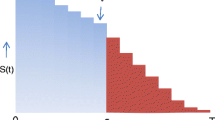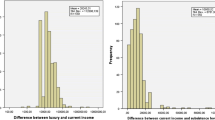Abstract
To estimate the discount rate for lives saved in the future a number of studies have been carried out on the trade-off between saving lives now and in the future. A telephone survey is administered to about 1,700 individuals to test if the framing of the question affects the estimated trade-off. In one sample the question is framed as saving 100 lives today versus saving x future lives and in one sample the question is framed as saving 100 future lives versus saving y lives today. The result shows that the framing has a major impact on the trade-off.
Similar content being viewed by others
References
Brookshire, David S., and Don L. Coursey. (1987). “Measuring the Value of a Public Good: An Empirical Comparison of Elicitation Procedures,” American Economic Review 77, 554–566.
Cairns, John. A. (1994). “Valuing Future Benefits,” Health Economics 3, 221–229.
Cropper, Maureen L., and Paul R. Portney. (1990). “Discounting and the Evaluation of Lifesaving Programs,” Journal of Risk and Uncertainty 3, 369–379.
Cropper, Maureen L., Sema K. Aydede, and Paul. R. Portney. (1991). “Discounting Human Lives,” American Journal of Agricultural Economics 73, 1410–1415.
Cropper, Maureen L., Sema K. Aydede, and Paul R. Portney. (1992). “Rates of Time Preference for Saving Lives,” American Economic Review 82, 469–472.
Cropper, Maureen L., Sema K. Aydede, and Paul R. Portney. (1994). “Preferences for Life Saving Programs: How the Public Discounts Time and Age,” Journal of Risk and Uncertainty 8, 243–265.
Dreyfus, Mark and W. Kip Viscusi. (1995). “Rates of Time Preference and Consumer Valuations of Automobile Safety and Fuel Efficiency,” Journal of Law and Economics 38, 79–105.
Gately, Dermot. (1980). “Individual Discount Rates and the Purchase and Utilization of Energy-Using Durables: Comment,” Bell Journal of Economics 11, 373–374.
Greene, William H. (1993). Econometric Analysis, 2nd Ed. New York: Macmillan.
Hammack, Judd, and Gardner M. Brown, Jr. (1974). Waterfowl and Wetlands: Toward Bioeconomic Analysis. Baltimore, MD: Johns Hopkins University Press.
Hausman, Jerry A. (1979). “Individual Discount Rates and the Purchase and Utilization of Energy-Using Durables,” Bell Journal of Economics 10, 33–54.
Hershey, John C., Howard C. Kunreuther, and Paul J.H. Schoemaker. (1982). “Sources of Bias in Assessment Procedures for Utility Functions,” Management Science 28, 936–954.
Horowitz, John K., and Richard T. Carson. (1990). “Discounting Statistical Lives,” Journal of Risk and Uncertainty 3, 403–413.
Jones-Lee, Michael W. (1992). “Paternalistic Altruism and the Value of a Statistical Life,” Economic Journal 102, 80–90.
Knetsch Jack L., and John A. Sinden. (1984). “Willingness to Pay and Compensation Demanded: Experimental Evidence of an Unexpected Disparity in Measures of Value,” Quarterly Journal of Economics 99, 507–521.
Kriström, H., Bengt. (1990). “A Non-Parametric Approach to the Estimation of Welfare Measures in Discrete Response Valuation Studies,” Land Economics 66, 135–139.
Loewenstein, George, and Richard Thaler. (1989). “Intertemporal Choice,” Journal of Economic Perspectives 3, 181–193.
Loewenstein, George, and Drazen Prelec. (1992). “Anomalies in Intertemporal Choice: Evidence and an Interpretation,” Quarterly Journal of Economics 107, 573–597.
Mitchell, Robert C., and Richard T. Carson. (1989). Using Surveys to Value Public Goods: the Contingent Valuation Method. Washington, D.C.: Resources for the Future.
Moore, Michael J., and W. Kip Viscusi. (1988). “The Quantity Adjusted Value of Life,” Economic Inquiry 26, 369–388.
Moore, Michael J., and W. Kip Viscusi. (1990a). “Discounting Environmental Health Risks: New Evidence and Policy Implications,” Journal of Environmental Economics and Management 18, S–51–S–62.
Moore, Michael J., and W. Kip Viscusi. (1990b). “Models for Estimating Discount Rates for Long-Term Health Risks Using Labor market Data,” Journal of Risk and Uncertainty 3, 381–401.
Olsen, Jan A. (1993). “Time Preferences for Health Gains: An Empirical Investigation,” Health Economics 2, 257–265.
Rowe, Robert D., Ralph C. d'Arge, and David S. Brookshire. (1980). “An Experiment on the Economic Value of Visibility,” Journal of Environmental Economics and Management 7, 1–19.
Thaler, Richard. (1981). “Some Empirical Evidence on Dynamic Inconsistency,” Economics Letters 8, 201–207.
Tversky, Amos, and Daniel Kahneman. (1981). “The Framing of Decisions and the Psychology of Choice,” Science 21, 453–458.
Tversky, Amos, and Daniel Kahneman. (1991). “Loss Aversion in Riskless Choice: A Reference-Dependent Model,” Quarterly Journal of Economics 106, 1039–1061.
Viscusi, W. Kip. and Michael J. Moore. (1989). “Rates of Time Preference and Valuations of the Duration of Life,” Journal of Public Economics 38, 297–317.
Author information
Authors and Affiliations
Rights and permissions
About this article
Cite this article
Johannesson, M., Johansson, PO. Saving Lives in the Present Versus Saving Lives in the Future—Is There a Framing Effect?. Journal of Risk and Uncertainty 15, 167–176 (1997). https://doi.org/10.1023/A:1007786418821
Issue Date:
DOI: https://doi.org/10.1023/A:1007786418821




